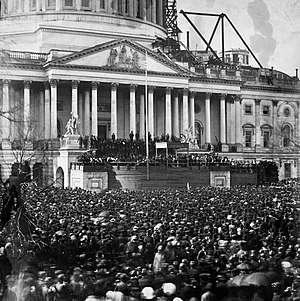Discovery of America (statue)
Discovery of America is a large marble sculpture group, by Luigi Persico, which was assembled in front of the east façade of the United States Capitol building from 1844 to 1958 and then put into storage.
| Discovery of America | |
|---|---|
| Artist | Luigi Persico |
| Year | 1844 |
| Type | White marble |
| Dimensions | 486.4 cm × 255.3 cm × 184.2 cm (191 1⁄2 in × 100 1⁄2 in × 72 1⁄2 in) |
| Location | Formerly East Facade of the United States Capitol (In storage), Washington, DC |
History
It was commissioned in 1837, modeled in 1839, and carved in 1840–1843. It was exhibited at the east façade of the United States Capitol, from 1844 until 1958, when it was removed and never restored.[1]
After years of protest, in 1958, both Discovery and another statue of similar nature, The Rescue by Horatio Greenough, were removed from the east façade in preparation for the building's extension. They were placed in storage and — without public discussion — never restored.[2]
Description

The statue depicts Christopher Columbus holding aloft a globe as an Indian maiden, cowering nearby, looks on. The depiction of Columbus is very different from the traditional portraits, rendering him as a bearded, hawk-faced and stern-eyed figure clad in traditional Conquistador armour. Usually Columbus is shown in flowing Renaissance robes with an astrolabe or a spyglass in hand to represent his title of "Admiral of the Ocean".
President James Buchanan described the statue as representing "the great discoverer when he fust bounded with ecstacy upon the shore, ail his toils past, presenting a hemisphere to the astonished world, with the name America inscribed upon it. Whilst he is thus standing upon the shore, a female savage, with awe and wonder depicted in her countenance, is gazing upon him." [3]
Columbus is clearly the dominant figure in the statue as the Indian woman gazes up at him with a combination of both awe and fear. In this way, the statue references the popular early to mid 19th century notion of Manifest Destiny through the allegory of Americans spreading civilization and more specifically, Christianity, to the natives who they considered to be savages. As a result of this symbolism, the statue seems to act as a justification of the legislative actions of Andrew Jackson to approve the Indian Removal Act, which resulted in severe consequences for native people.[4]
Fate
The statue is said to be in poor condition.[5]
References
- "Discovery of America, (sculpture)". Inventories of American Painting and Sculpture. Retrieved February 14, 2012.
- Fryd, Vivien Green (1987), “Two Sculptures for the Capitol: Horatio Greenough's ‘Rescue’ and Luigi Persico's ‘Discovery of America’” American Art Journal, Vol. 19, No. 2 (Spring, 1987), pg 93.
- Congressional Globe, April 28, 1836, p. 1316.
- Fryd, Op. cit., pg 22-24.
- Fryd, Op. cit., pg 96.
External links
| Wikimedia Commons has media related to Discovery of America (Persico). |
- Brown, Glenn (2007). "Chapter XX Sculpture". History of the United States Capitol (PDF). Government Printing Office. ISBN 978-0-16-063263-1. Archived from the original (PDF) on 2012-01-30. Retrieved 2012-02-13. (first edition 1903)
- "Statue of Columbus and an Indian girl". René & Peter van der Krogt. Retrieved February 14, 2012.